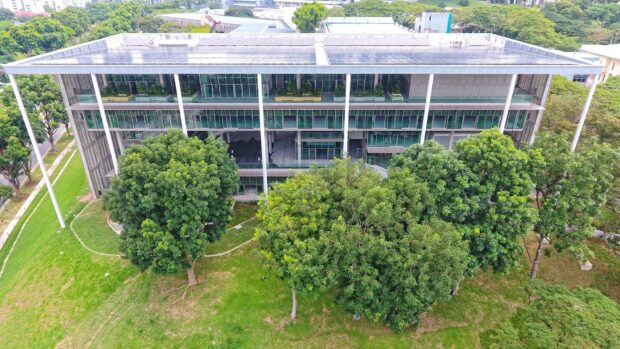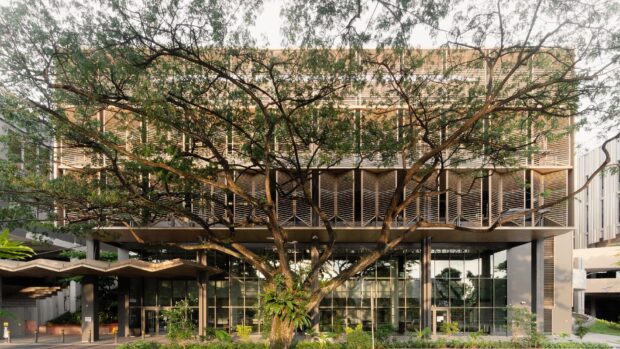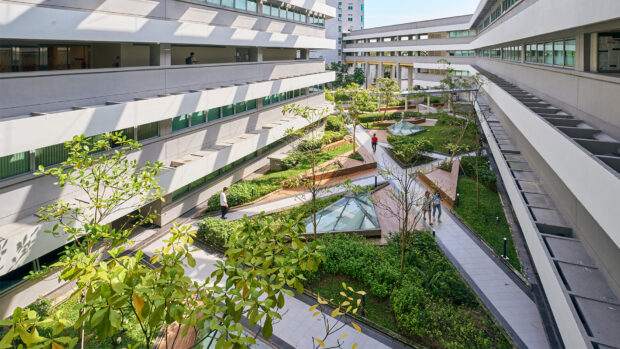Setting benchmarks for sustainable innovation

SDE4, Singapore’s first new-build net-zero building, was awarded Zero Energy Certification by the International Living Future Institute. (HTTPS://NEWS.NUS.EDU.SG)
With the world grappling with the urgent challenges of climate change, environmental degradation is not a distant threat. It’s an immediate and undeniable reality. As professionals in the built environment, we bear a significant responsibility to address this crisis.
We must integrate sustainability into our design thinking to minimize our impact on the environment. One powerful strategy in this endeavor is the creation of net-zero buildings. But what exactly is a net-zero building, and how can it make a difference?
Achieving balance
What is NZEB or net-zero buildings? These are structures designed to produce as much energy as they consume over the course of a year.
In essence, they achieve a balance between the energy they use and the energy they generate on-site. This is achieved through a combination of energy-efficient design, renewable energy sources, and innovative technologies. The goal is to reduce greenhouse gas emissions associated with the building’s operations to virtually zero.
The urgency to embrace these building practices cannot be overstated. The built environment industry is responsible for a significant portion of global greenhouse gas emissions, primarily through energy consumption for heating, cooling, lighting, and appliances. By transitioning to net-zero buildings, we can significantly reduce our carbon footprint and contribute to the global effort to combat climate change.
Shining example
The National University of Singapore’s School of Design and Environment (NUS SDE) 3 and 4 stand as a shining example of Singapore’s unwavering commitment to sustainability in the built environment.
This cutting-edge development serves as a model for other projects worldwide, showcasing innovative approaches to sustainable design, construction, and operation. It demonstrates seamlessly integrating systemic thinking design principles into every aspect of a building’s lifecycle.
From the initial to execution phase, sustainability is at the forefront. The buildings incorporate passive design strategies, harness renewable energy sources, and prioritize resource efficiency.
Energy efficiency
One of the standout features of the NUS SDE 3 and 4 is its commitment to energy efficiency. The buildings are designed to minimize energy consumption through natural ventilation, efficient lighting, and insulation.
Additionally, their rooftops are adorned with a vast array of solar panels, which harness the abundant Singaporean sunlight to generate clean energy. This not only reduces the buildings’ carbon footprint but also contributes to the nation’s clean energy goals.
In terms of water system, Singapore is well-known for its innovative water management strategies, and the NUS SDE 3 and 4 reflect this commitment to water conservation.

The NUS SDE 3 and 4 serve as an educational hub for sus- tainable design and innovation. (HTTPS://NEWS.NUS.EDU.SG)
The buildings incorporate rainwater harvesting systems, collecting, and reusing rainwater for irrigation and toilet flushing. This sustain- able approach reduces water consumption and pressure on local water sources.
Improved air quality
The extensive greenery throughout the vicinity not only enhances the visual appeal of the buildings but also contributes to improved air quality and biodiversity. Vertical gardens and plant-covered facades create a harmonious blend of architecture and nature.
This green infrastructure demonstrates Singapore’s dedication to urban sustainability and the creation of healthy, liveable spaces.
Beyond its physical attributes, the NUS SDE 3 & 4 serves as an educational hub for sustainable design and innovation. It inspires students, architects, engineers, and the wider community to embrace sustainability as a fundamental aspect of future development. This commitment to education ensures that sustainable principles are passed on to future generations, fostering a culture of environmental stewardship.
The urgency of climate change requires immediate and concerted action. As professionals in the built environment, we have a pivotal role to play. By embracing the principles of net-zero building design, we can create sustainable, energy-efficient structures that benefit both people and the planet.
The transition to net-zero buildings is not just a choice: it’s a necessity in the face of climate change. As we move forward, let us draw inspiration from innovative projects like the NUS SDE 3 & 4 and work collaboratively to build a more sustainable world for current and future generations. The time for action is now, and net-zero buildings are a crucial part of the solution.
This is to remind us that through innovative design and unwavering commitment, we can create buildings that not only meet our needs but also contribute to a more sustainable and resilient future for all.
Author: Ar. Joan De Leon-Tabinas
A Singapore-based Filipino architect stands out as a visionary presence in the world of sustainability-focused architecture. Arch Tabinas is Co-founder and Director at Green Building Experts Pte Ltd (GBuildEX), a pioneering company dedicated to green and sustainability education. She also spearheaded CORE+, an enterprise amplifying architectural and engineering excellence, propelling sustainable and efficient workflows. Simultaneously, Arch Tabinas is the brain behind CORE360 Solutions- Centre of Resilience Environmental Experts. These initiatives are the testaments to her unwavering commitment to weaving ecological design principles seamlessly with the fulfilment of human needs. For her ‘Sustainability is not a choice, it must be essential part of the norm’.

